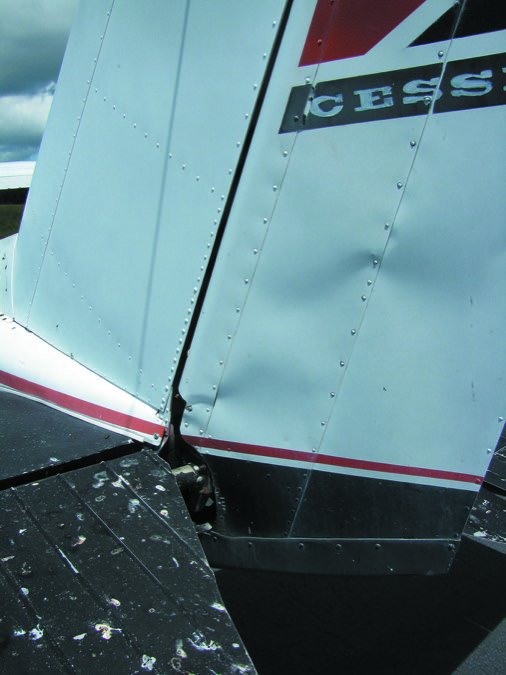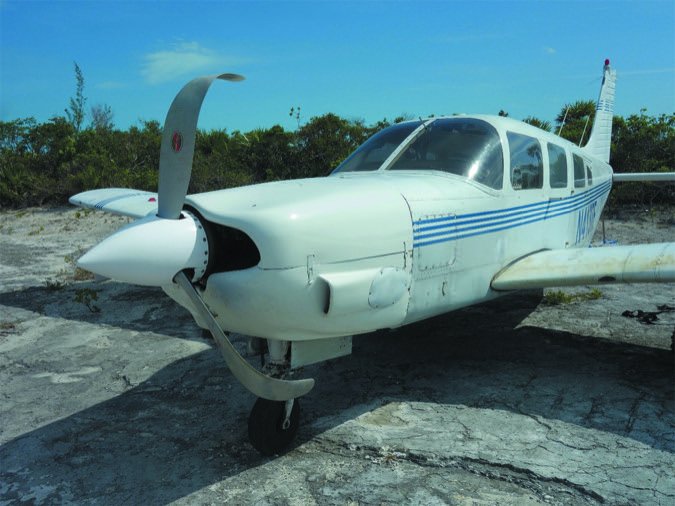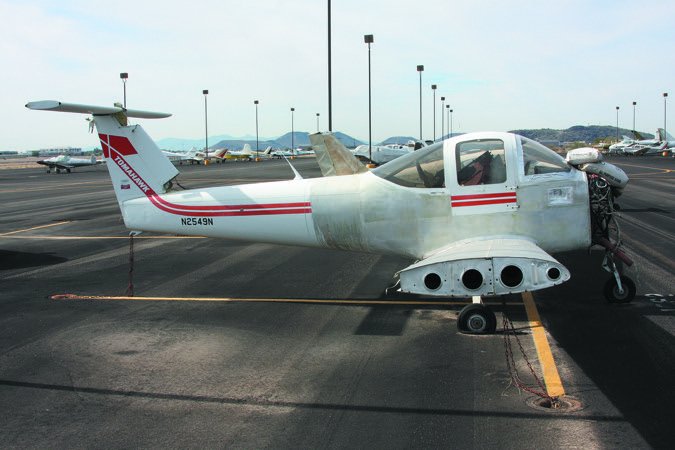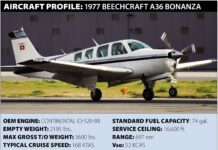Spend much time around aircraft owners or a maintenance facility and you’re likely to hear the term “ferry permit.” What’s being talked about is what the FAA calls a “special flight permit.” It’s the paperwork the agency uses to approve the flight of an aircraft “that may not currently meet applicable airworthiness requirements but is capable for safe flight.” Perhaps the most common reason for a special flight permit is lack of an annual inspection within the preceding 12 months.
The FAA has been issuing special flight permits since it came into existence and while the terminology and procedures have changed with the times, the immediate takeaway for aircraft owners and pilots is there is a provision in the FARs for operation of non-airworthy aircraft. That’s the large print. The small print holds that there are many provisions, aspects and components to relevant regulations, including FARs 21.197 and 21.199. With that in mind, this discussion will center on general aviation piston-powered airplanes weighing 12,500 lbs. or less at gross weight and operated under FAR Part 91.
Parsing the Regs
Authorization for a special flight permit is found in FAR 21.197, which includes specific references to several different instances where a permit may be issued. Of those instances, we’ll focus on flying the aircraft to a base where repairs, alterations or maintenance are to be performed, or to a point of storage.

The most important part of FAR 21.197 states: “A special flight permit may be issued for an aircraft that may not currently meet applicable airworthiness requirements but is capable of safe flight.” The key words here are “may” and “safe flight.” Two provisions of interest are evacuating an aircraft from areas of impending danger (hurricane provision) and operation of an aircraft at a weight more than its maximum certificated takeoff weight. Overweight operations would be limited to long-range flights over water or land where there are no facilities for refueling and would not allow for passengers or cargo to be carried.
Procedures for requesting a special flight permit are spelled out in Advisory Circular 21-12C, Application for U.S. Airworthiness Certificate, and ultimately is all about completing FAA Form 8130-6, Application For U.S. Airworthiness Certificate. The AC is quite lengthy—51 pages—and has many instructions unrelated to special flight permits for maintenance, alterations, repair etc. Sections 2 and 7 are the only portions of the form that need to be completed. Once the form is completed, it’s submitted to the nearest FAA office. Although the AC doesn’t say so, that generally means the local Flight Standards District Office (FSDO) and a maintenance inspector. It’s also noteworthy that Form 8130-6 is to be completed by the registered owner of the aircraft or his/her registered agent.
Define ‘Airworthy’

At right, the prop on this Piper Saratoga got curled when the airplane was landed gear-up. At bottom, the rudder on this Cessna suffered some kind of damage, perhaps from wind. Neither condition is airworthy since the damage precludes the aircraft from conforming with its type certificate. Unless there’s visible damage like this, no one can determine with a mere glance at an aircraft if it’s airworthy. To many, if all the big parts are still attached, the engine starts and it has fuel, it meets their definition. To the FAA, airworthiness is a bit more complicated.
There are a couple of definitions. FAR 3.5(a) states, “Airworthy means the aircraft conforms to its type design and is in a condition for safe operation.” That’s a good start. FAA Order 8130.2J, Airworthiness Certification of Aircraft, carries with it the imprimatur of U.S. national policy and includes a slightly different take: “An aircraft with a type certificate (TC) is airworthy when it conforms to its U.S. TC and is in a condition for safe operation. For the purpose of this order, a non-type-certificated aircraft is airworthy when it is in a condition for safe operation.”
But that’s not all. There’s FAR 91.7, which mandates pilots fly only airworthy aircraft:
(a) No person may operate a civil aircraft unless it is in an airworthy condition.
(b) The pilot in command of a civil aircraft is responsible for determining whether that aircraft is in condition for safe flight. The pilot in command shall discontinue the flight when unairworthy mechanical, electrical, or structural conditions occur.
One of the things required to maintain a type certificate is the annual inspection called for in FAR 91.409, and it’s typically one of two reasons an aircraft isn’t legally airworthy. The other reason is an airworthiness directive (AD). If a condition the AD is designed to remedy is found on the aircraft, it’s not airworthy. If the aircraft must be flown to a location where the appropriate repairs can be made, a ferry or “special flight” permit may be necessary. — J.B.
A Ferry Flight Checklist

– Once you determine that a ferry flight is necessary, consider these recommendations on obtaining it:
– Make up a list of all the items that need to be checked and ensure they all are addressed prior to a ferry flight.
– Consider the pilot’s experience with the type of aircraft to be flown—not just legal currency but recent flight experience in the exact make and model of aircraft. Things do go wrong occasionally, and the pilot may need to make quick decisions on continuing the flight or landing in a field.
– Allow plenty of time for the flight. Planning to arrive just before sunset or in marginal conditions may be legal but isn’t very smart should anything go wrong.
– Although you may be able to file IFR, your permit may not allow operations in IMC.
– Be professional and polite—don’t just fax an application to the FAA. Call early on to discuss your special flight request. Be honest with the details.
– Be able to answer questions they might ask, including when the last annual inspection was performed and why you need the special flight permit. If the request is reasonable and the operation appears to be safe, you most likely will obtain the special flight permit.
Why a special flight permit?
As discussed above and in the sidebar on the preceding page, the most common way an aircraft becomes non-airworthy is an expired annual inspection. Other circumstances can have the same result, including an accident or damage to the aircraft. An airworthiness directive (AD) also may result in a non-airworthy, presuming the AD allows ferry flights.

While a mechanic may deem an aircraft safe for a one-time flight, the pilot has the final word as to whether it is safe to fly or not. Every FAA office I have ever worked with has been very cooperative in assisting me or my customer in obtaining a special flight permit. However, there are several rules they must follow.
For example, a special flight permit will not be issued for international flights. An international flight requires application for a special flight permit be made to the appropriate authority of the country you will be flying over or into. Also, deviation from any Part 91 regulation may not be allowed, depending on the situation, the aircraft and the FAA office you are dealing with. This would include items listed as required equipment in FAR 91.205, i.e., airspeed indicator, altimeter, compass, fuel gauges, etc.
Some equipment may be inoperative and the aircraft could be capable of safe flight but that determination must be made on a case-by-case basis regarding the aircraft and redundant systems. Inoperative or unknown condition of retractable landing gear, for example, could be a reason for a special flight permit if the aircraft can be operated safely with the landing gear locked and pinned in the down position.
Circumstances not considered eligible for a special flight permit can include an inoperative transponder. Although it may be a required item to operate in certain circumstances, a broken transponder does not make an aircraft non-airworthy. For such a problem, refer to FAR 91.215, which includes the proper procedures to allow operating the aircraft. Maintenance personnel familiar with your aircraft can assist in determining whether a gear-down flight is feasible and what provisions are necessary to ensure its safety. In any event, the pilot must keep in mind that some conditions—like flying a retractable with its landing gear down and locked—demand operational consideration. For example, the airplane will use more fuel and aircraft performance may suffer. An absurd example might be flying in IFR conditions when the airplane’s electrical system is inoperative.
Practical Procedures
It’s common for an FAA office to require a licensed mechanic or appropriately rated repair station to check (not inspect) and verify the aircraft is capable of a safe one-time flight. Before getting involved in the process of obtaining a ferry permit and spending money needlessly, discuss your proposal with a licensed mechanic or repair station to determine the feasibility of the proposed operation and what the cost might be. Be honest with yourself and your mechanic, and provide the logbooks, an accurate description of the situation and what your plan or goal is.
While a plane may be out of annual by only a week, when was the last time it was flown? Has it been a week, a month or several months or even years? Has there been any damage—hail or parts of the hangar falling on the plane, or becoming partially submerged in a flood—since the last time it was flown? This is important as to what the condition of the plane is and what it may need to make it safe to fly.
Not every application for a special flight permit will be approved. Be realistic and don’t expect a flight to be approved if the plane is clearly unsafe to fly. It is very important that you do your homework and don’t miss anything in the special flight permitting process; don’t rush it. Thorough photo or video documentation can be an appropriate means for a third party evaluating the plane and required work to make it airworthy. This avoids the “he said, she said” misunderstandings, or at least helps a great deal.
The FAA may require that certain maintenance procedures be done prior to a flight under such a permit. This can include draining fuel and oil and replenishing with fresh fluids. Any outstanding AD notes are another consideration and must be included in the evaluation by a mechanic to determine if a special flight permit may be issued in the first place.
A special flight permit will have specific instructions regarding the aircraft’s operation. These usually include that only required crew (a certificated and properly rated pilot) will be allowed to operate the aircraft and that no cargo or passengers will be permitted. Another common restriction is that the flight be conducted in daylight VMC, although filing IFR may be allowed. Occasionally, a specific route may be specified, or there may be a prohibition on flying over densely populated areas. All kinds of combinations and restrictions could be specified, so it’s important to discuss the proposed flight with the FAA so neither party is surprised.
Final thoughts
Be realistic in considering a ferry permit. There are a lot of variable situations that make one operation safe, but another could be completely unsafe. Seek professional help from a maintenance person familiar with the aircraft in question and make an informed decision on whether the aircraft is safe to fly.
There are times when it may be necessary to contact a designated airworthiness representative (DAR) and pay for an on-site inspection of the aircraft and issuance of a special flight permit. If the DAR determines that the aircraft is not safe for flight he/she would list the reasons and work with you to make the aircraft safe for flight. Expect to pay a premium for these services.
At the end of the day, a special flight permit is something the appropriate FAA offices deal with all the time, even if you don’t. Be respectful of the FAA inspector’s questions and concerns about the proposed operation, and make sure you comply with any requirements spelled out on the permit. Don’t embarrass the FAA inspector granting the permit: He or she may also be the one to initiate an enforcement action if something goes wrong.
Mike Berry is a 17,000-hour airline transport pilot, is type rated in the B727 and B757, and holds an A&P ticket with inspection authorization.



